Schneider Shorts 1 July 2022 – with a Welsh Nobelist’s new scam, fraudster’s German husband and his fountain of youth, a surprise retraction, an unsurprising correction, Cheshire and his fraudsters, and a dirty old man succeeding a dirty old man in Marseille.
Table of Discontent
Science Elites
- Raoult’s worthy successor – his IHU colleague Pierre-Edouard Fournier to continue the tradition of fraud, patient abuse and sexual harassment
- Sir Martin’s new scam – look what Nobelist Martin Evans and his young fellow Ajan are up to now!
- Dr Paus’ Fountain of Youth – a German celebrity scientist irons all wrinkles
Scholarly Publishing
- Surprise retraction – Alexander Magazinov scores at Nature Publishing Group
- Our sincerest apologies – Oncogene corrects a paper
News in Tweets
Science Elites
Raoult’s worthy successor
As you all know, the chloroquine guru Didier Raoult has been forced to retired from all his positions, he will be relinquishing his directorship of IHU Marseille by the end of summer and go into well-deserved retirement.
So whom did the head of recruitment committee Louis Schweitzer, former CEO of Renault, investigator of paedophilia scandal at the Paris university Sciences Po and wiretapper of journalists (read here), recruit as Raoult’s successor?
Did you really expect someone external, someone honest, someone who is not a toxic covidiot quack and who was not actively involved in patient abuse? Come one, this is France!
Raoult. Une folie française: book review by Alexander Samuel
A critical review of a recent book about chloroquine guru Didier Raoult and the many French politicians who let him operate above the law.
Didier Raoult fraud: “Je ne regrette rien”
One year on: more fake data, financial fraud and illegal and falsified clinical trials by the chloroquine guru Didier Raoult.
The winner is of course another IHU crook: Pierre-Edouard Fournier
The dude who issued ethics approvals for Raoult’s illegal human experiments with chloroquine, who is the direct boss of Raoult’s chloroquine pusher Philippe Gautret, and who managed COVID-19 PCR tests for their clinical trials and who provided a pseudo-peer-reviewed journal platform for Raoult’s publishing scams.
Here is IHU’s official announcement from 29 June 2022.
Fabrice Frank told me Fournier’s story:
“Risky positions taken during the Covid-19 pandemic
Less publicized than some of these colleagues, Professor Pierre-Edouard Fournier nevertheless took some clear-cut positions during the Covid-19 pandemic.
Thus, as early as March 2020 he declared, regarding the hydroxychloroquine-azithromycin treatment, that “Preliminary tests show rapid eradication of the virus thanks to this therapeutic combination”. […] Incredulous at the arrival of a second wave to which epidemiologists were already warning, he declared in May 2020 that “the risk of a ‘rebound’ is less and less likely” and that “Yes, in my opinion it is possible today to ‘breathe’ and resume a life as normal as possible.” […]
Scientific publications and editorial conflicts of interest
Professor Pierre-Edouard Fournier is a central element of the system set up by Professor Didier Raoult to ensure a maximum of publications, citations and ultimately SIGAPS points and therefore public funding, without valuable scientific compensation. The example of the [journal] “New Microbes New Infections” (NMNI) is particularly explicit in this respect.
Indeed, it was found that this journal published an abnormally high number of publications from the IHU Méditerranée Infection [Locher et al 2021]. Its editorial board also includes an abnormally high number of members of the IHU, despite recent replacements likely put in place by the publishing company Elsevier.
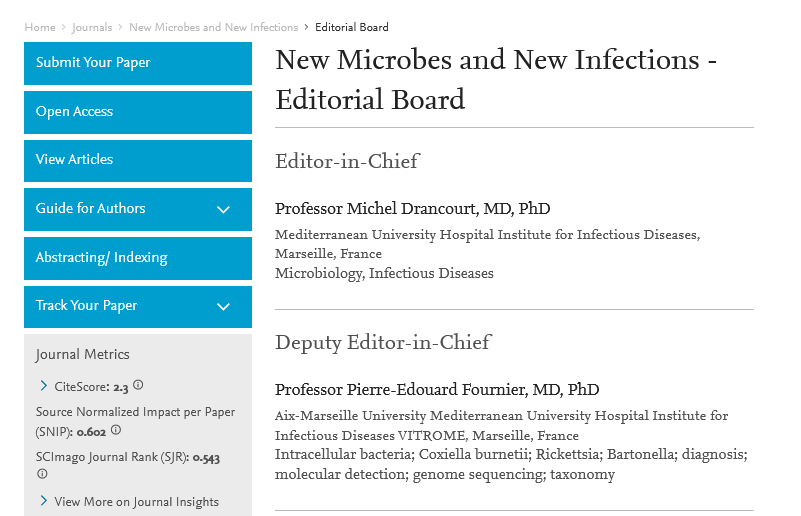
Indeed, when in October 2021, the Express reveals that the same authorization number from the IHU ethics committee was used to publish 247 articles relating to various types of samples on different continents, the name of Professor Pierre-Edouard Fournier appears prominently in the list of beneficiaries of this system which raises serious questions of editorial conflicts of interest.
It is also present in many recent studies which do not seem to meet the legal requirements governing clinical research on the human person [Ayona et al 2021, Cassir et al 2021]. There is also a comparative study of Covid-19 antigen tests dating from 2021 clearly mentioned as prospective and not having CPP authorization and whose last author is Professor Pierre-Edouard Fournier [Fenollar et al 2021].
The lightness with which the peer review of this journal treats the ethical aspect of its publications also meets other concerns.
On ethical and regulatory issues concerning clinical trials, including on vulnerable people
Indeed, a comment posted on PubPeer shows that a prospective study on healthy volunteers would have been conducted by members of the IHU on the homeless, i.e. vulnerable populations . The corresponding study [Ly et al 2021] counts Professor Pierre-Edouard Fournier among its authors. The comment posted on PubPeer also refers us to a copy of the authorization from the ethics committee internal to the IHU Méditerranée Infection on which we discover that he is also the secretary of this ethics committee which gave its agreement for this study which was not the subject of a CPP authorization.
There is another mention of his function in this ethics committee in a thesis [p54 here]. This second opinion bears the reference 2020-001. It is mentioned in several comments on PubPeer [Francis et al 2021, Haddad et al 2020, La Scola et a 2020]. It actually appears in 5 studies, but in the case of three of them, patients from the prospective hydroxychloroquine study were recruited. This leaves no doubt about the prospective nature of these 5 studies. However, they have not been the subject of a request for authorization before a CPP as the law provides, and the secretary of this internal ethics committee at the IHU Méditerranée Infection who grants authorization in order to be able to publish these articles is Professor Pierre-Edouard Fournier.
As such, he would have been a signatory of the authorizations of this internal ethics committee which allowed all the publications on the studies pinpointed by the ANSM in its report of April 27, 2022, including several transmitted by the ANSM to the prosecutor.
Involvement in excesses of governance
As reported in a document from the registry of the Court of Marseille, Professor Pierre-Edouard Fournier is one of the founders of the start-up Technojouvence. The secretary of the meeting reported in this document is provided by Eric Ghigo. However, it is this researcher who was dismissed from the CNRS and removed from the IHU for acts of sexual and moral harassment, and it is thanks to this startup and the collaboration of Professor Pierre-Edouard Fournier that he was able to find a place in the premises from which he had been removed.“
You can read about Eric Ghigo’s sexual harassment and racism, and how Raoult protected him here:
Chloroquine genius Didier Raoult to save the world from COVID-19
As COVID19 pandemic rages on, French microbiologist Didier Raoult offers a cure. President Trump is convinced, but is Raoult’s research reliable, here and in general?
So now, under the new leadership, IHU will continue with criminal patient abuse, research fraud, sexual harassment, racism and antisemitism as before. In fact, strike that, they won’t just continue. I was informed that IHU will be promoted from being some state-money-abandoned backwater institute to the nation’s central epidemiological reference authority. Which means not only that all IHU crooks are exonerated, they are actually promoted, and will now, led by Raoult’s buddy Fourier, get to have their revenge on all their critical peers in the country.
Some critics are already being sued, some will be sacked, others will be silenced.
C’est la France.
France’s Ugly Brown Derriere
“legions d’honneurs, prix, promotion…. Le champ du cygne de ce système politico médical qui n’a plus le choix que de se soutenir mutuellement. Patience, en d’autre temps, on a donné des médailles aux derniers combatants. On connait la fin” – Capitaine Eric Chabriere.
Maybe it is France and not Ukraine whose corruption problem should preclude it from being a member of the EU?
Sir Martin’s new scam
My regular readers might wonder what Britain’s most beloved Nobel Prize laureate, Sir Martin Evans, is up to these days. Is he still doing business with Ajan Reginald, the struck-off dentist, pathological liar and professional crook?
Of course he does!
Requiem for Celixir
How the Nobel Prize winner Sir Martin Evans and the lying crook Ajan Reginald almost succeeded, were it not for Patricia Murray.
Their stem cell scam Celixir went defunct after Professor Patricia Murray exposed the many lies and massive fraud behind the company’s magic cell therapy for heart attack sufferers. A clinical trial in London was cancelled based on the evidence she submitted to authorities. Even The Telegraph reported.
Ajan was in need of a new income source and soon found work with another biotech, Novacyt, which sought to defraud the UK public with phony COVID-19 tests. Private Eye reported about it, and Ajan abruptly left the company in January 2022.
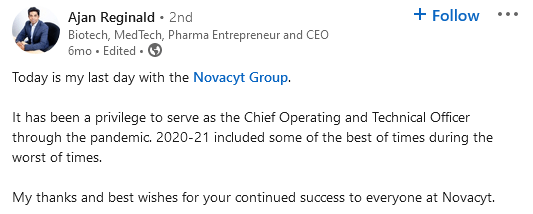
Where will our heroes earn money now to escape abject poverty?
After their Cell Therapy Ltd/Celixir (which claimed to cure heart attack with magic iMP cells), Ajan and Sir Martin founded Oncogeni, a company which claims to cure cancer with magic MK cells.
They partnered with a certain Darrin Disley, a very questionable biotech entrepreneur who owns the regenerative medicine scam business Mogrify, and “developed a proprietary direct cellular conversion technology, which makes it possible to transform (transmogrify) any mature human cell type into any other without going through a pluripotent stem cell- or progenitor cell-state“. You laugh, but Disley’s Mogrify quackery raised many millions and is even funded with public tax money. And Mogrify used to have another British star scientist on board, Stephen P Jackson (and now he is one of Mogrify’s investors!).
Steve Jackson and the Moumen Troll
“I take issues of research integrity very seriously and shall of course review the concerns posted on PubPeer to establish whether there are any issues that need to be addressed.” Stephen P Jackson.
Abderrahmane Kaidi leaves Bristol after misconduct findings
University of Bristol mysteriously lost its senior lecturer, Abderrahmane Kaidi. His institutional website was wiped out in August 2018. I obtained an internal email which lifts the mystery: Kaidi was namely found guilty of “having fabricated research data”, and resigned with “immediate effect”. Affected by research misconduct are also publications from Kaidi’s postdoc period with Stephen…
And now Ajan and Sir Martin, together with Disley, sold their Oncogeni right before anyone exposes the quackery: take the money and run.
Sir Martin and Ajan, the stem cell gold-diggers
Sir Martin Evans, winner of Nobel prize 2007, founded in 2009 the stem cell start-up Celixir, together with a struck-off dentist Ajan Reginald. With the help of the British heart surgeon Stephen Westaby, they ran a very profitable clinical trial in Greece, which now moved into UK.
Here the biotech news:
“Medical biotechnology company, Roquefort Therapeutics, has conditionally agreed to buy UK biotech Oncogeni Ltd in return for shares.
Oncogeni develops novel patented cancer medicines, and will receive 50 million shares, worth just under £4 million ($4.9 million).
In light of the acquisition, Oncogeni co-founder Ajan Reginald will become chief executive of the group, and co-founder Martin Evans will be appointed as chief scientific officer.”
Questionable activities of UK company Celixir, by Patricia Murray
Patricia Murray uncovers the business secrets of the Nobelist Martin Evans and his partner Ajan Reginald. It seems the magic iMP cells used to treat patients in Greece were drawn from the blood of patients in Swansea, for the purpose of a secret PhD thesis. There is no serious science behind it, only serious investor…
As reminder, Sir Martin won the Nobel Prize in 2007 for the discovery of embryonic stem cells, and he has been monetising his Nobel since day 1, especially by founding Cell Therapy Ltd/Celixir. Despite his old age, Evan’s greed obviously knows no limits, so here is what he and Ajan invented now:
“Oncogeni is focused on two areas of cancer research: small interfering RNA (gene silencing) and mesodermal killer (MK) cells.
MK cells research is a relatively new area where cellular medicine is engineered to kill cancer cells and enhance the effect of natural killer cells that also target the disease.
Roquefort is also acquiring lab and manufacturing facilities as part of the deal and the placing will introduce new shareholders, including the Japanese drug developer Daiichi Sankyo and CH Health, a specialist biotech venture capital investor.”
Celixir-critic Murray: “MHRA is prioritising business interests over patient safety”
Liverpool professor Patricia Murray continues investigating shady dealings of the regmed company Celixir, owned by struck-off dentist Ajan Reginald and Nobelist Sir Martin Evans
Wait what? Daiichi Sankyo? This company gave in 2016 Ajan and Sir Martin for the iMP cell licence an upfront fee of £12.5 million, you can imagine what Ajan did with the cash, in any case, it’s gone. Presumably, the Japanese wanted their money back after Celixir went tits up, but Ajan offered them something much better: shares in Oncogeni!
There is even a company presentation:
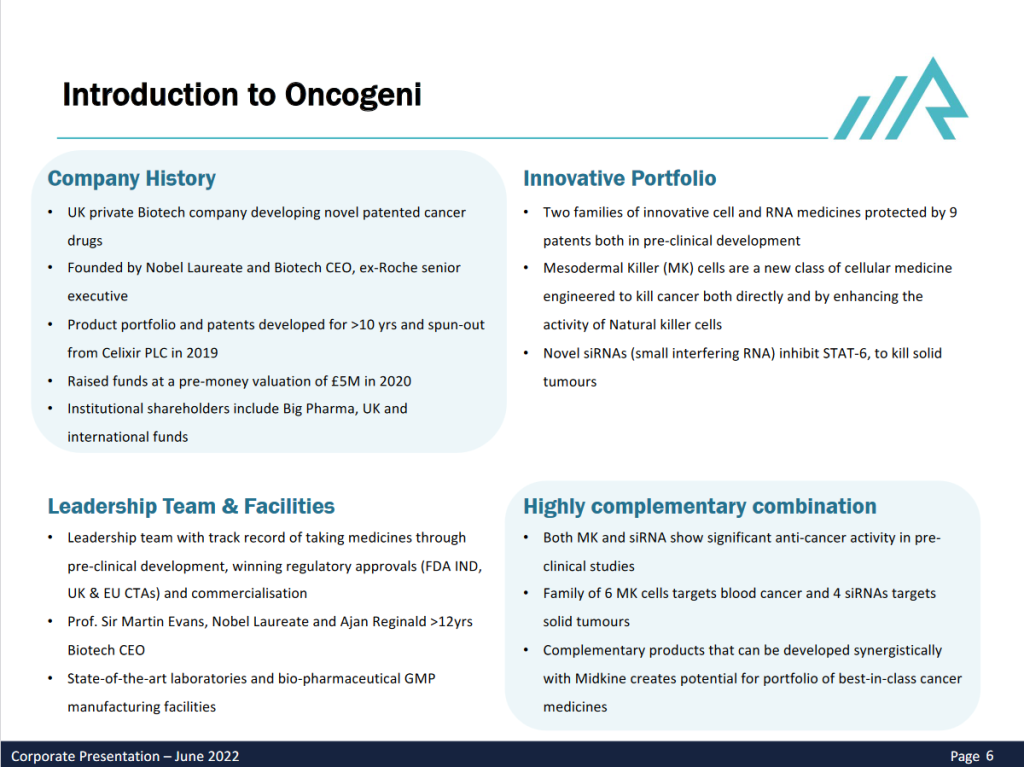
The MK cells of Oncogeni are at least as magical as the iMP cells of Celixir:
- “Novel engineered anti-cancer cell type invented by Nobel Laureate, Prof. Sir Martin Evans
- Engineered to kill cancer directly, attract NK cells and to activate (prime) NKs to kill cancer
- Designed to be well tolerated with a low risk of serious side effects associated with CAR-T“
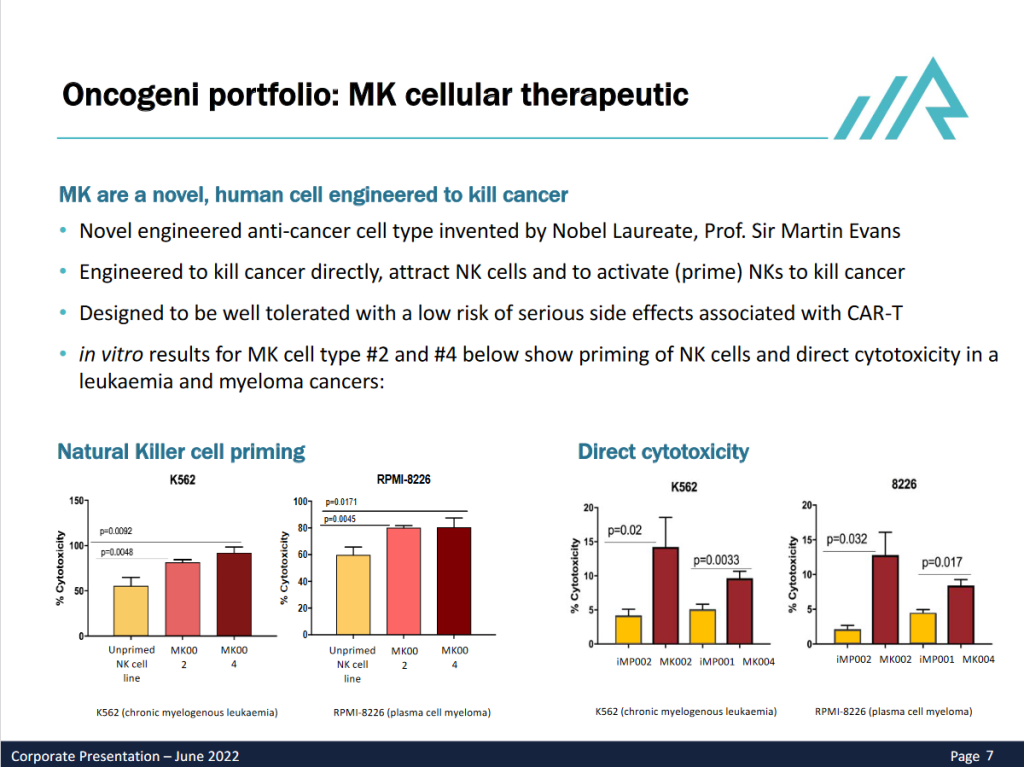
For those among you still hoping that Britain’s beloved Nobelist must be senile and demented, locked up in his bedroom by the all-controlling Ajan, crying into his pillow while helpless to protest about his involuntary involvement in Ajan’s scams: Sir Martin is very active in fact, travelling to cash-in on yet another speaker’s fee.
Here he just issued some awards in Wales, on 2 June 2022:
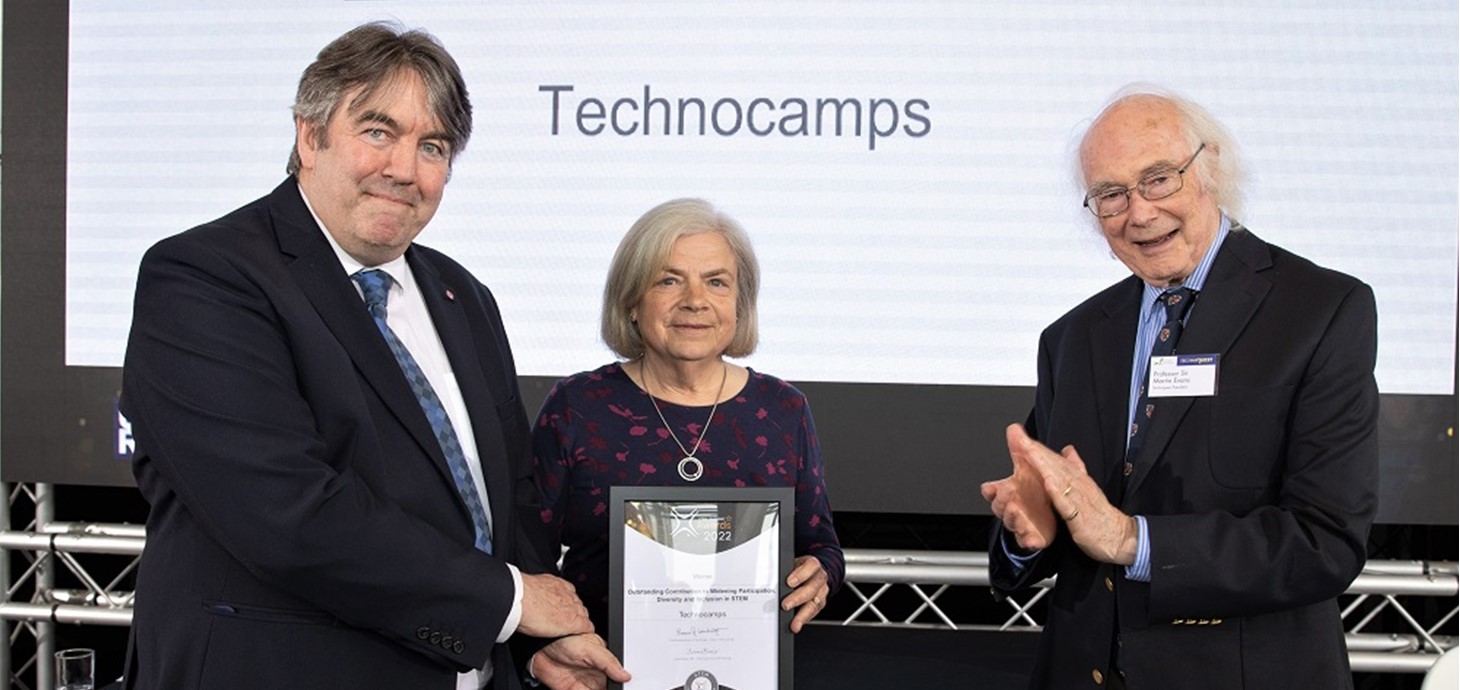
And afterwards, on 19 June 2022, he even travelled to Cyprus to give an opening lecture at the local trash university:

Btw, University of Cyprus and its School of Medicine is where the UCL fraudster Anastasis Stephanou is now employed as professor, and the dean and Evan’s host Elizabeth Johnson is another special case. Read here:
Cell Death and Depravity
Is the journal Cell Death and Disease a disease itself, parasitised by Chinese paper mills? Can it be cured? Not with this team of doctors on editorial board.
All you have to do to find research fraudsters is to follow one of them around.
Dr Paus’ Fountain of Youth
Israeli Scientists teaming up with German private clinic entrepreneurs are an unstoppable force. Jerusalem Post excitedly reports:
“Have scientists at Haifa’s Rambam Health Care Campus and the Technion-Israel Institute of Technology and colleagues abroad – after two decades of research – discovered the fountain of youth? This omnipresent human desire seems closer to fulfillment, at least in laboratory mice, on whom the researchers discovered a mechanism for rejuvenating human organs. […]
Using an old skin graft on young mice, they proved that it is possible to make skin and other organs young again via a change in molecular structure through all the layers of the skin.”
The modest “fountain of youth” formulation is not even journalists’ own, but from Rambam’s press release. This is their paper:
Aviad Keren , Marta Bertolini , Yaniv Keren , Yehuda Ullmann , Ralf Paus , Amos Gilhar Human organ rejuvenation by VEGF-A: Lessons from the skin. Science Advances (2022). DOI: 10.1126/sciadv.abm6756
The abstract declares:
“Transplanting aged human skin onto young SCID/beige mice morphologically rejuvenates the xenotransplants. […] While intradermally injected VEGF-loaded nanoparticles suffice to induce a molecular rejuvenation signature in aged human skin on old mice, VEGF-A treatment improves key aging parameters also in isolated, organ-cultured aged human skin, i.e., in the absence of functional skin vasculature, neural, or murine host inputs. This identifies VEGF-A as the first pharmacologically pliable master pathway for human organ rejuvenation in vivo and demonstrates the potential of our humanized mouse model for clinically relevant aging research.”
The conflicts of interests are:
“M.B. and R.P. are employees of, and A.G. is a consultant for, Monasterium Laboratory GmbH, Münster, which performs dermatological contract research for the industry (www.monasteriumlab.com) but has no commercial interest in VEGF-related research or products. R.P. is the CEO of CUTANEON GmbH, Hamburg, which has an interest in the development of skin aging–related products, but holds no VEGF-related patents.”
The German dermatologist and paper’s co-author Ralf Paus owns as founder and CEO both companies, Monasterium Laboratory and CUTANEON, which is “dedicated to the development of ground-breaking cosmeceuticals, nutraceuticals, and dermatological drugs“. It is also absolutely not true that Paus has no interest in VEGF-related therapies: in 2021, he announced VEGF inhibitors to be “a novel personalized treatment approach for psoriasis” in a peer reviewed paper where we are assured that “The authors have no conflicts of interests to declare.” In that paper, Paus mentioned:
“Transgenic expression of VEGF-A in experimental models led to the development of skin lesions that share many psoriasis features.”
Right…
Personally, I fully endorse VEGF therapies, preferably with nanoparticles, for rich old gits seeking to smooth their wrinkles in private clinics in Germany and in Israel. Let them get psoriasis, cancer and whatever else those VEGF treatment may result in (but certainly not rejuvenation).
Btw, Professor Paus retired at several universities, probably to focus on his business? University of Lübeck: retired. University of Münster: retired. University of Manchester: retired. University of Miami: not sure, but looks like it.
But maybe these retirements are somehow connected to Ralf Paus being the husband of Silvana Bulfone-Paus? Yes, hers was Germany’s biggest research fraud scandal a decade ago, which went through all the national news. There were 12 retractions and research misconduct findings by DFG (read here). Der Spiegel mentioned in 2012:
“Ralf Paus, husband of Bulfone-Paus, is also under suspicion of manipulation. Disciplinary proceedings are underway against him and his wife at the University of Lübeck, where both hold professorships. The scientists deny the allegations and have taken legal action, says university press spokesman Rüdiger Labahn. Neither the results of the commission of inquiry nor details of the disciplinary proceedings are known.”
Zombie Scientists
There are zombie papers, those are the long-discredited or even misconduct-riddled publications, which somehow avoid retractions and continue contaminating scientific literature. The “Arsenic Life” paper in Science is such a parade example, but also cancer and stem research hide an impressive collection of zombie papers. Zombie scientists are those once renowned researchers, who were caught…
The zombie scientist Silvana Bulfone-Paus however remains professor at University of Manchester where she still leads a lab and publishes papers, in MDPI and Frontiers. And her husband makes some serious money back in Germany by providing perfectly reliably and scientifically impeccable preclinical dermatology research services to paying clients in academia and industry. Even training PhD students in process.
Scholarly Publishing
Surprise Retraction
Alexander Magazinov once tried to get a fraudulent paper retracted. It was this one:
Rady E. El-Araby, Mahmoud A. Khalifa , Mona M. Zoheiry , Manal Y. Zahran , Mohamed I. Rady , Raafat A. Ibrahim , Mohamed D. El-Talkawy , Faiza M. Essawy The interaction between microRNA-152 and DNA methyltransferase-1 as an epigenetic prognostic biomarker in HCV-induced liver cirrhosis and HCC patients Cancer Gene Therapy (2020) doi: 10.1038/s41417-019-0123-9
For the standards of this Nature Publishing Group journal, which is full of Chinese papermill fabrications, the Egyptian paper didn’t even look that obviously fake.
In October 2021, Magazinov posted his concerns on PubPeer and shared them with the publisher Springer Nature and COPE:
“I found a series of 4 papers.
(A) DOI 10.1186/s43042-020-0048-8, in Egyptian Journal of Medical Human Genetics.
(B) no DOI immediately available, https link, in Al-Azhar Journal of Pharmaceutical Sciences.
(C) DOI 10.1038/s41417-019-0123-9, in Cancer Gene Therapy.
(D) DOI 10.1016/j.genrep.2019.100452 in Gene Reports.
(A) and (B) cite the same approval document, (C) and (D) also cite the same approval document, different from (A) and (B).
The authors listed for (C) and (D) are the same. For (A) and (B) the author lists are slightly different, and different from (C) and (D), but have a large overlap.
Of interest are socdem + lab analyses + ultrasound result tables. The N values are different between (A) and (B) / (C) and (D). Moreover, the numbers for cirrhosis / splenomegaly / ascites patients are different across all tables, suggesting that these studies deal with 4 different samples. However, despite differences, there are many unnaturally repeated values across the tables, which the reader will easily spot.[…]
For (C) numbers of male / female members in groups 1a and 2 do not add up to respective N. The same numbers and the same inconsistency are in (D), too.”

On 8 November 2021, COPE asked the journal’s academic editor Georgios Giamas and the publishes Springer Nature to investigate. Now, Giamas, professor at the University of Sussex, is a protege of the infamous research cheater, quack healer, patient scammer, Imperial College professor and Oncogene editor Justin Stebbing. Giamas has with and without Stebbing an impressive record of forged data on PubPeer, one particularity fraudulent paper (Giamas et al NAR 2009) was eventually retracted.
Oncogene EiC Justin Stebbing, a hypocrite of research integrity?
‘The results have been replicated by ourselves or others, so the image manipulation is irrelevant.’ – Justin Stebbing, double bluffing
So you can’t expect much from Giamas. But Virginia Mercer, Senior Editor for Medicine and Life Sciences at Springer Nature, announced to investigate. On 28 February 2022, she informed Magazinov:
“I have discussed your comment with the Editor-in-Chief and the authors and we don’t agree there is an issue here or that anything else needs to be done.
The ROC curve is correct and the settings that were made are correct. The only difference was in the gender column, where there were unwritten cases, but they were modified in the correction, the rest of the parameters in the study were prepared correctly.
Here we are talking about the number of the samples not the interpretation/validity of the data.
The authors provided all the raw data so we don’t think there is anything of concern.“
A correction was issued in parallel. But on 22 June 2022, Mercer informed COPE:
“For your information, this paper has now been retracted.“
That was because Magazinov found more issues with that paper, namely in Figures 3, 4, 5 and 6.



The lead author Rady E. El-Araby announced to issue another correction, but apparently failed.
The retraction notice from 22 June 2022 went:
“The Editor-in-Chief has retracted this Article. After publication, concerns were raised regarding the numbers of patients in various groups in Table 3, which the Authors addressed via Correction [1]. However, further similar issues have been identified in Figs. 3–6, which affect the results and conclusions of this study. The numbers of data points in these figures do not match the group descriptions in the Materials and methods. Additionally, the Authors’ subsequent study [2] appears to report the same patient recruitment period from the same institution as well as the same inclusion and exclusion criteria, but contains a higher number of patients than this Article. The Authors have been unable to sufficiently explain these discrepancies.”
As you can read, the credit for Magazinov’s investigation went entirely to the Editor-in-Chief Georgios Giamas. Maybe Springer Nature find it funny. But then again, they also find it funny to keep Giamas and Stebbing as editors. At least there was a retraction, because at Wiley Magazinov was much less successful.
Wiley: Committed to integrity? Get out!
“We have initiated post-acceptance peer review with independent reviewers… ” – Wiley.
Here is a paper from Giamas PhD period in Germany:
Georgios Giamas, Heidrun Hirner , Levani Shoshiashvili , Arnhild Grothey , Susanne Gessert , Michael Kühl , Doris Henne-Bruns , Constantinos E. Vorgias , Uwe Knippschild Phosphorylation of CK1δ: identification of Ser370 as the major phosphorylation site targeted by PKA in vitro and in vivo Biochemical Journal (2007) doi: 10.1042/bj20070091


This was also fixed with a correction.
Our sincerest apologies
Speaking of Stebbing and his Nature publishing group journal Oncogene.
Look what they corrected:
Jie Zheng , Hui Zhang, Ranran Ma , Haiting Liu , Peng Gao Long non-coding RNA KRT19P3 suppresses proliferation and metastasis through COPS7A-mediated NF-κB pathway in gastric cancer Oncogene (2019) doi: 10.1038/s41388-019-0934-z

The lead author Jie Zheng (or maybe actually the papermill manager impersonating his distraught customer) commented on PubPeer in April 2022 and soon after, on 12 May 2022 a Correction was published with an almost identical text:
“The authors mistakenly uploaded the representative images of the si-KRT19P3-1 group (Fig. 3B SGC7901 migration and invasion). The authors have restored the correct Transwell images in Fig. 3B as below. This correction does not influence the results of our study’s conclusion. We sincerely apologize for any inconvenience caused.”
But of course there was more, as Hoya Camphorofolia found out:

Appreciate the overlay:


Jie Zheng again replied:
“We select one of the representative images for publication and save the other images. all the experiments have been repeated at least 3 times, there is no effect on the interpretation or conclusion of this article.The unintentional errors might cause misunderstand to the editor, reviewers and readers. The authors take full responsibility for this unintentional error. To better reduce the effect of these mistakes, The corrections were made as above.Most importantly, we regret the mistake, we offer our sincerest apologies for our mistakes and oversight as it was never our intention to mislead any readers. We ensure that something like never happens again. Best wished to you!“
And reminded everyone that the paper has already been corrected, case clsoed.
Now you tell me: why is Springer Nature keeping such characters like Stebbing and Giamas as their Editors-in-Chief? Is it despite or because of their own fraud records? Is it despite of their tolerance for Chinese papermill fraud, or exactly because of it?
Are these publishers really sad about the papermill infestations, or angry about my sleuths colleagues finding them out?
News in Tweets
- Springer Nature corrects another utterly fake paper (Thenmozhi et al 2015). Why such tolerance for fraud? Well, an associate editor of Neurochemical Research is antivaxxer and covidiot Michael Aschner (on board of various pseudoscience quackery journals of Elsevier).
Elsevier’s Pandemic Profiteering
Aristidis Tsatsakis, Konstantinos Poulas, Ronald Kostoff, Michael Aschner, Demetrios Spandidos, Konstantinos Farsalinos: you will need a disinfecting shower once you read their papers.
Elsevier pandemic profiteering, again
“a scientific journal is not a social network, not even a newspaper. People reading papers in FCT are expected to be scientists with a good basis to distinguish between trash and science.” EiC Jose Luis Domingo on new paper by Peter McCullough
- Rule Number One in Scholarly Publishing: Proclaim loudly (chest beating, legs spread, etc) that nobody cares more about research integrity than you. Then publish all the fraud you get your hands on, earn good solid cash in the process. As this little Italian papermill journal, European Review for Medical and Pharmacological Sciences, does.
Il Piccolo Mulino Verduci Frodatore
“I choose to think of the paper-mills as something like a mediaeval monastic scriptorium, with one table of tonsured monks working on the text, while the limners at another table illuminate the Figures.” – Smut Clyde
- The lab of Abdellah Mansouri at UMR 1149 Inserm – Université Paris Diderot has been naughty. Cheshire’s PubPeer findings here.
- Elsewhere in France, the lab of Pascale Jeannin at University of Angers has been naughty, too. Cheshire’s PubPeer findings here.
- Konrad Hochedinger, hailing from Germany, trained by Rudolph Jaenisch and now professor at Broad Institute in Harvard, is one of the biggest stem cell research bigwigs. Here likely a clue to his success. Btw, this fake paperwas also published in Oncogene: Hochedinger et al 2022.
- Smut Clyde plagiarised by Chinese authorities: “Concerns regarding data integrity were raised by the National Science Library of the Chinese Academy of Sciences, which were based on a PubPeer thread showing potentially hand-drawn flow cytometry histograms and western blots devoid of background with sausage-shaped bands (https://pubpeer.com/publications/E73F538F46E201FF3575C965B5147E)“. (Retraction notice for Wang et al 2019)
- Steve Kirsch made billions in IT, but as a covid expert he is an utter failure. Ivermectin, fluvoxamine, now look at this list:
Die with a smile: antidepressants against COVID-19
“Fluvoxamine could certainly be something you wanna put in the tool chest. ‘Cause it looks as if it has the promise to reduce the likelihood of severe illness.” – Francis Collins, NIH Director.
- Spiegel reports that Charité Berlin distances itself from their professor Harald Matthes, because of the “methodological weaknesses” in his ImpfSurv study about COVID-19 vaccinations where he claimed to have found massively under-reported side effects and accused Paul-Ehrlich-Institue of a cover-up (here is his ImpfSurv report). That is all very decent from Charité, but thing is, Matthes is president of the German Academy for Homeopathy and Naturopathic Treatment and board member of the Hufeland Society (for alternative medicine). His employment at Charité is financed since 2017 by an “Endowed professorship for integrative and anthroposophic medicine“, and yet, and yet the venerated science-devoted elite medical school doesn’t seem to be distancing themselves from the quack money Matthes brings.
- How the much-celebrated xeno-transplant of a gene-engineered pig heart to a human patient fared: “A week later, a second biopsy indicated that about 40 percent of the heart muscle cells in the transplant were dead or dying, even though there were still no indications of rejection in the tissue. That level of damage brought an end to things: “We concluded that an irreversible injury to the xenograft was present and, with the patient’s family at the bedside, compassionately withdrew life support on day 60 after transplantation.” (Ars Technica) Paper: Griffith et al NEJM (2022)
- Stephen Buranyi‘s long read in The Guardian about Darwinian evolution, modern synthesis theory and what the alternatives are: “There are certain core evolutionary principles that no scientist seriously questions. Everyone agrees that natural selection plays a role, as does mutation and random chance. But how exactly these processes interact – and whether other forces might also be at work – has become the subject of bitter dispute.“
- Swedish state prosecutor announced to appeal the Stockholm’s court decision to let the deadly trachea transplant surgeon Paolo Macchiarini walk out free with a suspended sentence (Independent).
- In memoriam. Although one does wonder if Dr Vovka Zelenko tried to cure his cancer with chloroquine, azithromycin and zinc. He was 49 and leaves behind 8 children, a wife, and a distraught community of antivaxxer covidiots.
Zelenko and Raoult fall in each other’s arms
The marriage of love between Didier Raoult and Vovka Zelenko is now official. It was ordained by the International Society for Microbial Chemotherapy. No COVID-19 restrictions apply, and there’s enough chloroquine for everyone.
I thank all my donors for supporting my journalism. You can be one of them!
Make a one-time donation:
I thank all my donors for supporting my journalism. You can be one of them!
Make a monthly donation:
Choose an amount
Or enter a custom amount
Your contribution is appreciated.
Your contribution is appreciated.
DonateDonate monthly


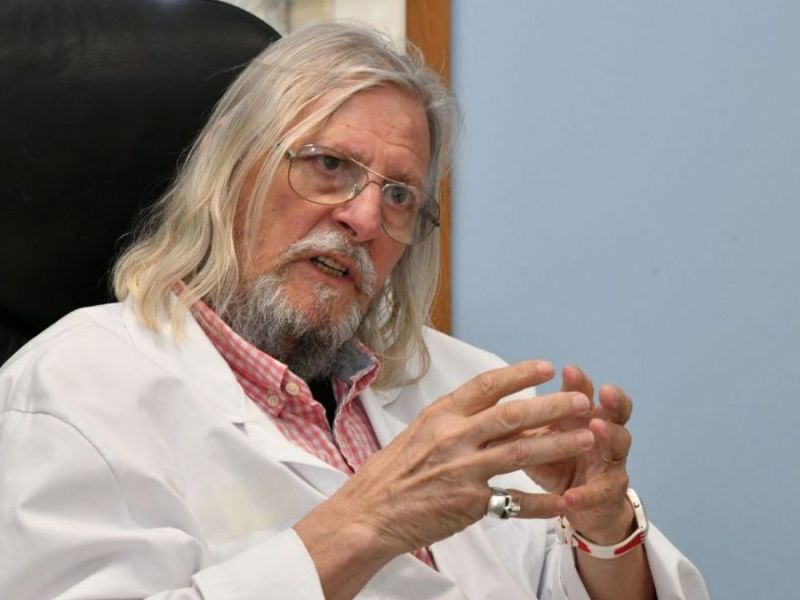









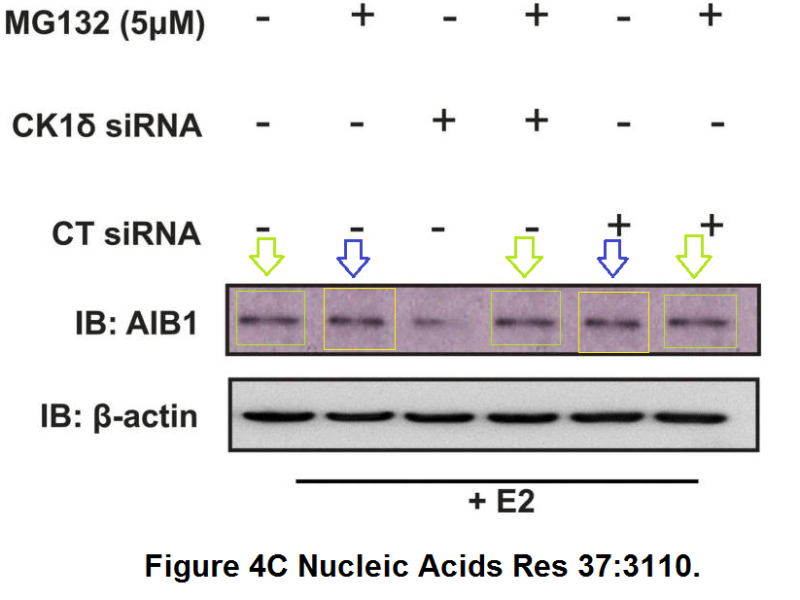





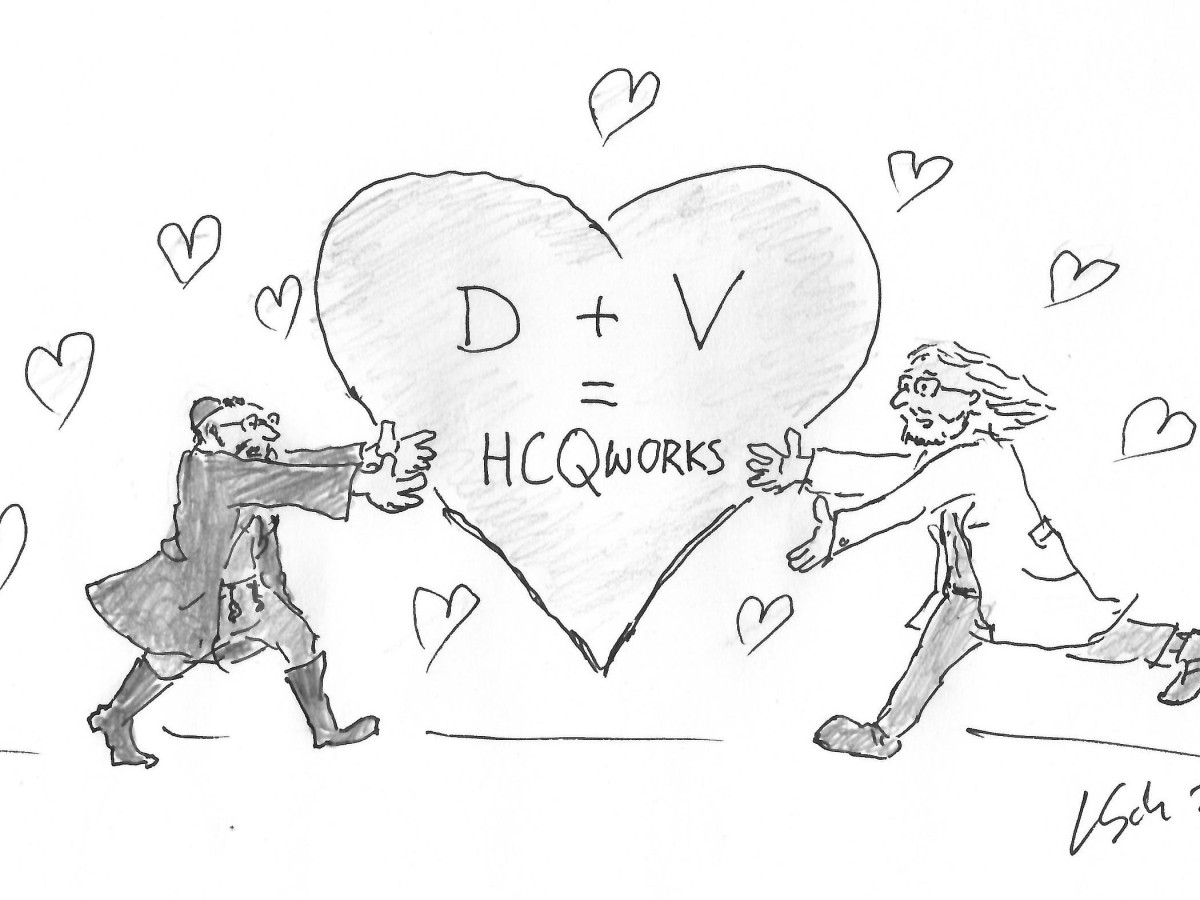

” There were 12 retractions and research misconduct findings by DFG (read here). ”
13 retractions.
https://retractionwatch.com/2011/12/13/bulfone-paus-retraction-count-grows-to-13-with-one-in-transplantation/
http://retractiondatabase.org/RetractionSearch.aspx#?auth%3dbulfone-paus
7 retractions for Ralf Paus.
http://retractiondatabase.org/RetractionSearch.aspx#?auth%3dPaus%252c%2bRalf
LikeLiked by 1 person
https://www.laborjournal.de/blog/?p=3978
Silvia Bulfone-Paus und die wilde 13
Dezember 2011 von Laborjournal
Zwölf Publikationen der Immunologin Silvia Bulfone-Paus vom Forschungszentrum Borstel sind wegen manipulierter Daten bereits zurückgezogen (siehe auch Laborjournal 7-8/2011, S. 16 ff. und 21). Jetzt kam mit dem 2000er-Paper „An Interleukin-2-IgG-Fas Ligand Fusion Protein Suppresses Delayed-Type Hypersensitivity in Mice by Triggering Apoptosis in Activated T Cells as a Novel Strategy for Immunosuppression“ in Transplantation (vol. 69: 1386-91) nochmals eine hinzu.
In der Retraction Note heißt es etwas spärlich:
The Editors and Publisher retract the article by Bulfone-Paus et al. published in Transplantation (Vol. 69, pp. 1386–1391, April 15, 2000) because of the inaccurate information provided for Figures 4 and 5.
LikeLike
Some details about Oncogeni:
LikeLike
Pingback: Short dell’oca – ocasapiens
Is the Guardian paper cited for irony or you see merits in it?
LikeLike
I know the author and he is a very good science journalist. This, for example:
https://www.theguardian.com/science/2017/jun/27/profitable-business-scientific-publishing-bad-for-science
But Buranyi’s new long read?
Not sure what to make of it. I think he noticed himself that there is actually no controversy about natural selection.
Just some academic egos desperate to be replace Darwin’s name with their own in textbooks 😉
LikeLike
On the topic of the Neo-Darwinian synthesis, he’s an absolute uninformed numpty.
https://whyevolutionistrue.com/2022/06/29/once-again-a-misguided-article-on-why-the-theory-of-evolution-is-obsolete/
LikeLiked by 1 person
Letter to Editor by Bard, Maxwell & Bibby.
https://www.theguardian.com/science/2022/jul/01/scientists-are-still-fleshing-out-darwins-theory-of-evolution
LikeLike
The Solna prosecutor is appealing against the two acquitals and the suspended sentence for Macchiarini. Fat lady not yet having her vocal moment. Info in Swedish here: https://www.dn.se/sverige/macchiarinidomen-overklagas-av-aklagare/
LikeLike
False treatments for a false virus and false pandemics. In addition, who really knows if viruses really exist and cause disease? What is the difference between extracellular vesicles, other extracellular particles, and viruses? Cannot be the disease caused by other factors affecting a whole population such as for example lack of vitamins? With Celixir I am not really surprised either, just a quest for money.
LikeLike
Raoult’s and Fournier’s dear friend Eric Ghigo has now been sentenced by a criminal court for sexual assault and sexual harassment to 18 months prison. 12 months were suspended completely and the remaining 6 months he will spend at home with electronic ankle bracelet. Meaning Ghigo can continue to work at IHU!
https://www.laprovence.com/actu/en-direct/6825997/jugement-affaire-push.html
LikeLike